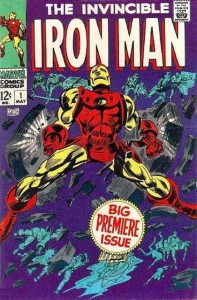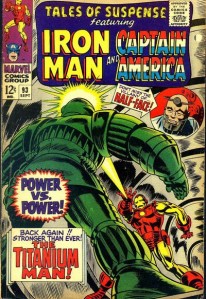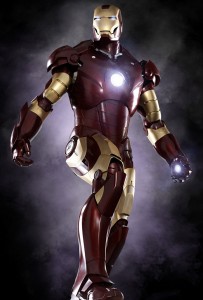 A few months ago, I received an invitation from Eivind Figenschau Skjellum here at Masculinity-Movies.com to write a guest review for the 2008 movie Iron Man. I was pleased and very honored to accept. My review is posted here on his site today. But there’s more to my relationship with Iron Man than a movie review. Much more.
A few months ago, I received an invitation from Eivind Figenschau Skjellum here at Masculinity-Movies.com to write a guest review for the 2008 movie Iron Man. I was pleased and very honored to accept. My review is posted here on his site today. But there’s more to my relationship with Iron Man than a movie review. Much more.
Iron Man and I go way back. I think I can reasonably say that he actually saved my life, twice as a matter of fact: once when I was a child and again when I was a man in my early thirties. More on that in a bit.
I still remember the first Iron Man comic I bought: Tales of Suspense #93, published in September 1967. This issue featured a battle between Iron Man and one of his chief nemeses at the time, a much larger armored counterpart from the Soviet Union named Titanium Man. The cover of the comic book showed Iron Man and Titanium Man facing off against one another inside a long, claustrophobic metal tunnel with the caption “POWER vs. POWER!” I was nine-going-on-ten and from the moment I saw that cover, Superman and Batman were old news to me. I was hooked on Iron Man.
One of my uncles, who was six or seven years older than me, had quite a comic book collection at that time and was more than happy to let me dig around in it, as he’d already moved on to James Bond movies, cars and girls. He had a few of the older Iron Man comic books, not all of them, but enough for me to become even more intrigued as I saw the progression of the Iron Man armor from the original, which looked something like a gray cast-iron wood stove, to a slightly less clunky golden version, to the familiar red-and-gold armor I recognized. Along the way, his helmet and face mask also changed several times, as did his power source and the array of features and weaponry built into the armor.
I also learned about his other identity, Tony Stark: inventor, industrialist, arms merchant, millionaire, playboy. And I learned about why he built the Iron Man armor, why he needed to continue to wear it, how it changed him, what it gave him, and what it cost him. I identified with this man who was brilliant but deeply injured inside, who built layers of protection and defense around himself so that he could deal with external threats, and who hid his true face behind the frozen expression of a metal mask. Tony Stark’s heart was wounded and so was mine, his from the fragments of a bomb that nearly killed him and mine from an angry, abusive, emotionally distant father, a ferocious giant who was my own “Titanium Man.”
I was in desperate need of some sort of positive masculine figure, even a fictional one, to help me cope with the difficulties of my life, and Iron Man came along just in time. I read my Iron Man comics. I played and pretended and fantasized. I wanted to be Iron Man. I needed to be. He saved my life by showing me that I could use my own ingenuity to protect myself, to armor myself up (psychologically, emotionally and physically), to hide my vulnerabilities, and to survive. In the process, I internalized Iron Man and his qualities in ways I couldn’t begin to understand at the time.
As I moved into my teens, I abandoned the comic books and moved on to other interests, much like my uncle before me. I gave my comics away to younger cousins and forgot about Iron Man. But my armor was still in place, and I continued to add new layers to it during my late teens and throughout my twenties as life brought more painful experiences, rejections and disappointments that I lacked the skills to handle with any real effectiveness.
Just before my 29th birthday, a woman for whom I cared deeply betrayed my trust with another man and broke my heart worse than it had ever been broken before (which was quite an accomplishment for any woman, given my history up to that point). Nothing I knew how to do for myself could reduce, or even manage, the pain I felt. At that point, I decided to break one the biggest taboos in my family of origin: I decided to seek help.
Not long after making that decision, I found myself working with an innovative counselor who used some very dynamic emotional release techniques. As my work with him progressed, emotional and psychological pathways began to open in me that had been closed down for a long time. One result of this opening was that I started dreaming prolifically. That was unexpected, and what was even more unexpected was that I began to have recurring dreams involving the Iron Man character that I loved so much as a child.
Initially, as a man moving into his thirties, I felt more than a little silly dreaming about a comic book character from my youth. But the dreams continued anyway, regardless of how I felt about them, and as time went on, I was more and more urgently compelled to understand why Iron Man had reentered my life. I found a guide who could help me work with my Iron Man dreams, to help me try to understand what they were all about and what I was being told. The assistance I received was critically important in helping me improve my understanding, but I knew I needed to do more. I found myself drawn to go out and find the old comic books I had when I was a kid. I bought Iron Man action figures. I made Iron Man collages. I worked and (perhaps more importantly) played with the image and the mythology of the character in every way that I could.
 The result of all this activity was another surprise: my first book, Iron Man Family Outing: Poems about Transition into a More Conscious Manhood, in which I wrote for the first time about the childhood experiences that originally drew me to Iron Man, the effects of those childhood experiences on my life as a young man, and my efforts to develop a greater understanding of myself and take a greater responsibility for my own life and my own healing. At the center of the book were a number of my Iron Man dreams, those initially inscrutable messages from deep within my psyche that had proven to be the keys to finding myself and saving my own life. For the second time, Iron Man had saved me.
The result of all this activity was another surprise: my first book, Iron Man Family Outing: Poems about Transition into a More Conscious Manhood, in which I wrote for the first time about the childhood experiences that originally drew me to Iron Man, the effects of those childhood experiences on my life as a young man, and my efforts to develop a greater understanding of myself and take a greater responsibility for my own life and my own healing. At the center of the book were a number of my Iron Man dreams, those initially inscrutable messages from deep within my psyche that had proven to be the keys to finding myself and saving my own life. For the second time, Iron Man had saved me.
At the time I did this work, there was no Iron Man movie. The character was very obscure and my relationship with him felt very personal, very special and very intimate. I usually had to explain who Iron Man was when I spoke about my experience with him to anyone. Things have certainly changed. Just about everybody has at least some idea of who Iron Man is now.
I’m glad that I had Iron Man to myself, so to speak, when I was dreaming about him. I’m glad that I had to put some time and effort into finding those old comic books and, if I was very lucky, even the occasional action figure. My process and my relationship with Iron Man were driven completely from within, from within my own memories, my own body, my own history and my own unconscious. There was almost no external source of information to mediate, influence or alter what I was being given from those mysterious sources deep within me. It was a very pure experience in that respect, as I believe it needed to be.
Given my extensive history with Iron Man, the news that the long-rumored and perpetually-delayed movie based on the character was finally coming was a matter of great personal interest to me, not simply as an exercise in escapist fantasy and entertainment, but as a filmic actualization of internal mythology and personal archetype. I followed all the media updates, starting in summer 2007, and was understandably eager to see the movie when it arrived in theaters in May 2008.
For the most part, I was pleased. Although the timeframe of the origin story had been modified and several storylines had been compressed in order to work within the constraints of a two-hour movie, Iron Man was still a very faithful adaptation that retained all of the original archetypal elements that captivated my imagination as a youngster. Robert Downey, Jr. was the perfect choice to play Tony Stark, completely believable at every step of Stark’s transformation from a careless hedonist who takes nothing seriously to a man who finally understands his path and his purpose in life. Iron Man even battled a much larger armored counterpart in the finale, just as he did in the very first Iron Man comic I bought as a child.
Still, the Iron Man in the movie didn’t feel like “my” Iron Man, and of course, it wasn’t. I can’t say I was surprised by this. I’d spent an enormous amount of time with that character and the associated mythology over many years, gone very deep with it, and alchemized it into something that’s totally personal and unique to me. It would have been ridiculous for me to expect any movie, no matter how well done, to match that.
Nevertheless, taken on its own terms the Iron Man movie has plenty to offer those who are interested in how certain aspects of masculinity and the male experience are expressed and represented on film, and I hope my review provides readers with some useful insights about some of the deeper themes found in the movie.
Iron Man is no longer front and center in my life in the way he once was. He very seldom comes to me in my dreams now. The old comics, action figures and collages from the time I spent with him in my early thirties are packed away in a box in my closet, keepsakes of another time in my life. I won’t be giving them away this time.
But the Iron Man who first came to me when I was an emotionally and psychologically wounded boy who needed a hero and a role model, and then reappeared twenty years later when I was a confused, distressed young man who’d forgotten who he was and could be, is still at work in my life and in the lives of others. He lives on in the book I was inspired to write by my dreams about him, and he comes to life in a new way in the mind and heart of every person who reads my story. Most of all, he lives on in me, because I wouldn’t be the person I am today without him.

